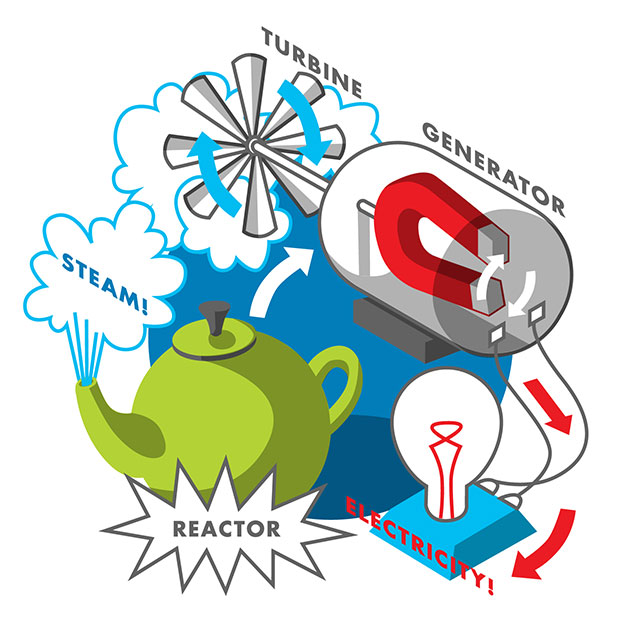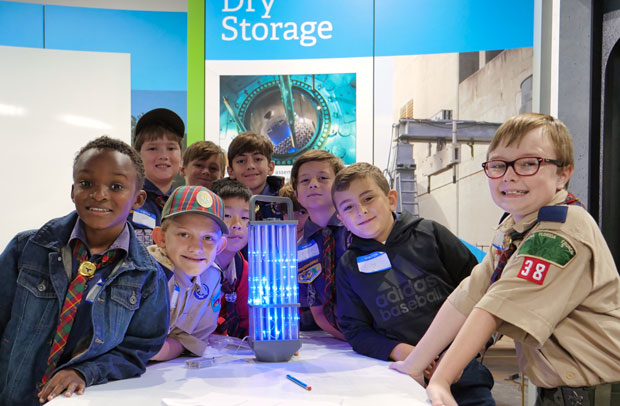Every atom counts when designing a reactor core
With refueling outages scheduled for Plant Vogtle and Plant Farley this fall, this is a great time to take a closer look at one of the most critical elements to the operation of a nuclear reactor—the actual fuel arrangement inside the reactor.
During a refueling outage, up to 40 percent of the fuel assemblies in the reactor core will be replaced. Depending on a plant’s design, a reactor core can contain up to 900 fuel assemblies, some of which have been in the core for one to three previous operating cycles that range from 18-24 months. Therefore, each assembly has a varying amount of energy potential available for the next cycle.
Some assemblies will be permanently removed from the reactor and the remaining assemblies must be reconfigured with new fuel that will be added. What’s the current condition and potential of the existing fuel? What should the enrichment level of the new fuel be? How should the new and remaining fuel be arranged in the core during the refueling process? Compound those questions with the variability of what the plant’s next operating cycle looks like in terms of length and power requirements and you’ve got yourself a challenge.
Enter the Southern Nuclear fuel engineering team. This team of fuel experts designs a safe, cost-effective and reliable core that contains enough energy to fuel one reactor for the next 18-24 months.
Described as “neutron accountants” for their ability to calculate and predict an individual fuel assemblies’ energy potential down to the atomic level, the fuel engineering department begins the design of a new core a year in advance. The more uranium-235 atoms the engineers can account for in each new and previously used fuel assembly means the more fission reactions that can occur. Ultimately those reactions produce the thermal energy the plant can convert into electrical energy.
Forty years ago, this was a pen and paper exercise. Today, engineers use powerful software programs that perform heavy-duty calculations on the variations that will affect power potential and economics. “There is still an art to designing a core, but these tools allow us to run a lot of different patterns in a short period. It used to take months to develop a single pattern but we can now produce 50 different options in a day,” said John Williams, nuclear fuel director for Southern Nuclear. “That computing power ultimately helps us provide a lower cost option for customers.”
Aside from selecting which fuel assemblies will be used, the exact placement of each assembly within the core is vital. Every fuel assembly must be placed based on potency and age to ensure the final core arrangement will sustain a consistent power level throughout the core. “Think of a pot of water that is only half-on the burner of a stove,” Williams explained. “The water and pot will have hot spots and cooler spots but the water is not going to boil as efficiently as it would if the entire pot was on the burner.”
Looking at the illustration below, you’ll see a checkerboard-like arrangement of fuel assemblies with each color representing a different enrichment level or time spent in the core. Blue squares represent fuel that has been in place for two previous cycles, white squares represent one cycle and the remaining colors represent new fuel with varying enrichment levels, red being the highest.
Notice that older fuel is placed on the perimeter of the core. Older fuel is less reactive and those assemblies mainly serve as a buffer to reduce the number of neutrons produced during the fission process from striking the reactor vessel — something that if allowed over time can weaken the vessel’s integrity. In contrast, just inside that outer ring is something Williams calls the “ring of fire” represented by several red squares. That’s new fuel that is enriched to a higher level than other assemblies. Those assemblies encircle the center of the core to facilitate a consistently high level of fission reactions throughout the other assemblies.
Eventually, three to four ideal patterns are identified and engineers finalize a pattern through a thorough design review and site visit with plant personnel. Once a pattern is selected, the team goes through a Reload Safety Analysis Checklist to ensure the design meets all Nuclear Regulatory Commission requirements. A Core Operating Limits Report is then compiled and provided to plant operators and the NRC detailing how the core should be operated. Lastly, an order is sent to industry partners such as AREVA, General Electric or Westinghouse. These companies facilitate the enrichment and fabrication of the individual fuel assemblies and work hand-in hand with Southern Nuclear personnel during the refueling process.
Once a plant enters the refueling outage, depending upon a plant’s design, each fuel assembly may be inspected and tested to confirm the positive integrity of the fuel and the assumptions fuel engineers made during the design process. From there, the new and selected used assemblies are arranged in reactor core while the spent fuel assemblies are transferred to each plant’s spent fuel pool to continue safely cooling for an interim period. Later that fuel will be transferred to dry fuel storage where the assemblies are housed in cylindrical containers constructed of steel or steel-reinforced concrete and lead.
Despite the intricacies and complexities of neutrons, powerful software and nuclear physics, Williams noted that the importance of a well-designed core is very straightforward, “The core needs to be designed in a manner that is safe and it needs to perform as economically as possible for our customers.”

